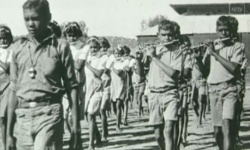
Picture of boys from the Stolen Generation
“Every morning our people would crush charcoal and mix that with animal fat and smother that all over us, so that when the police came they could only see black children in the distance. We were told always to be on the alert and, if white people came, to run into the bush or run and stand behind the trees as stiff as a poker, or else hide behind logs or run into culverts and hide. Often the white people – we didn’t know who they were – would come into our camps. And if the Aboriginal group was taken unawares, they would stuff us into flour bags and pretend we weren’t there. We were told not to sneeze. We knew if we sneezed and they knew that we were in there bundled up, we’d be taken off and away from the area.
| “
|
There was a disruption of our cycle of life because we were continually scared to be ourselves. During the raids on the camps it was not unusual for people to be shot – shot in the arm or the leg. You can understand the terror that we lived in, the fright – not knowing when someone will come unawares and do whatever they were doing – either disrupting our family life, camp life, or shooting at us.
|
”
|
Confidential evidence 681, Western Australia: woman ultimately surrendered at 5 years to Mt Margaret Mission for schooling in the 1930s, (quoted in HREOC, 1997, Chapter 2).
- Consider the quote above; what impact do you think living in fear that children would be removed would have on Aboriginal families?
Many of the members of the Stolen Generations were not provided with any information about their family or communities, so finding out that they are Indigenous creates complex issues of identity.
Key Ideas
The impact of child removal on Indigenous people who were removed, the descendants of those children, and the communities from which they were taken, is profound and ongoing.
Reflections
“Every morning our people would crush charcoal and mix that with animal fat and smother that all over us, so that when the police came they could only see black children in the distance. We were told always to be on the alert and, if white people came, to run into the bush or run and stand behind the trees as stiff as a poker, or else hide behind logs or run into culverts and hide. Often the white people – we didn’t know who they were – would come into our camps. And if the Aboriginal group was taken unawares, they would stuff us into flour bags and pretend we weren’t there. We were told not to sneeze. We knew if we sneezed and they knew that we were in there bundled up, we’d be taken off and away from the area.
Confidential evidence 681, Western Australia: woman ultimately surrendered at 5 years to Mt Margaret Mission for schooling in the 1930s, (quoted in HREOC, 1997, Chapter 2).
Many of the members of the Stolen Generations were not provided with any information about their family or communities, so finding out that they are Indigenous creates complex issues of identity.
Optional Reading/Resources
Dudgeon, P. & Hirvonen, T. (2014). Why me; why was I taken? It’s like a hole in your heart that never heal. In InPsych. August 2014.
Some of the most powerful accounts of the impact of the Stolen Generations come from Indigenous artists:
Audiovisual clip titled ‘Took the Children Away’ with music by Archie Roach:
Audiovisual clip of ‘Brown Skin Baby (They Took Me Away)’ by Bob Randall:
Content is available under the
Creative Commons Attribution Share Alike License.
Privacy Policy | Authors